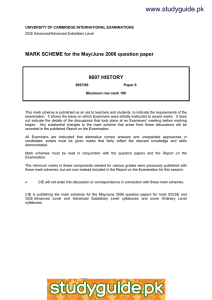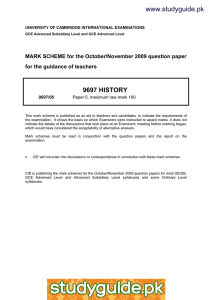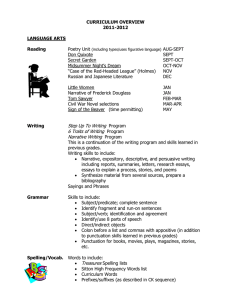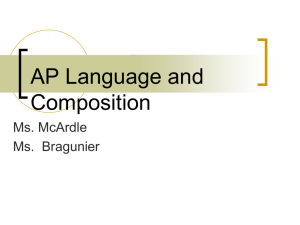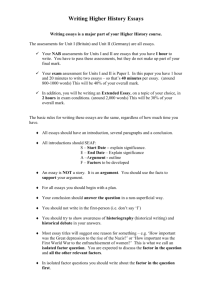MARK SCHEME for the May/June 2006 question paper 9697 HISTORY www.XtremePapers.com
advertisement
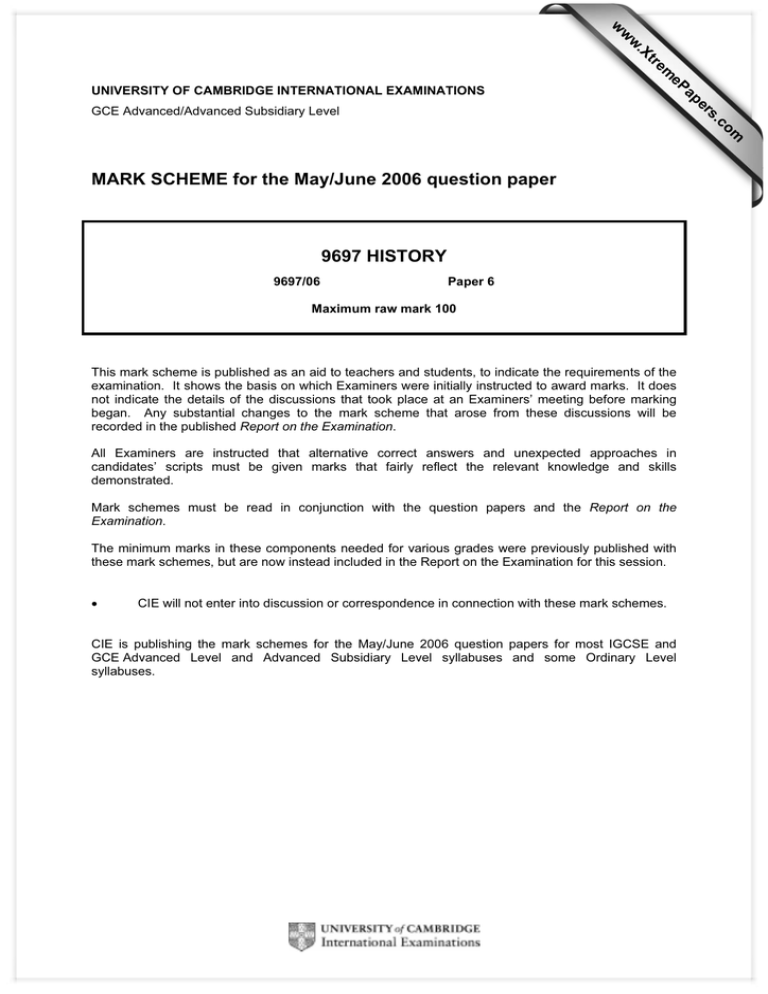
w w ap eP m e tr .X w UNIVERSITY OF CAMBRIDGE INTERNATIONAL EXAMINATIONS s er GCE Advanced/Advanced Subsidiary Level om .c MARK SCHEME for the May/June 2006 question paper 9697 HISTORY 9697/06 Paper 6 Maximum raw mark 100 This mark scheme is published as an aid to teachers and students, to indicate the requirements of the examination. It shows the basis on which Examiners were initially instructed to award marks. It does not indicate the details of the discussions that took place at an Examiners’ meeting before marking began. Any substantial changes to the mark scheme that arose from these discussions will be recorded in the published Report on the Examination. All Examiners are instructed that alternative correct answers and unexpected approaches in candidates’ scripts must be given marks that fairly reflect the relevant knowledge and skills demonstrated. Mark schemes must be read in conjunction with the question papers and the Report on the Examination. The minimum marks in these components needed for various grades were previously published with these mark schemes, but are now instead included in the Report on the Examination for this session. • CIE will not enter into discussion or correspondence in connection with these mark schemes. CIE is publishing the mark schemes for the May/June 2006 question papers for most IGCSE and GCE Advanced Level and Advanced Subsidiary Level syllabuses and some Ordinary Level syllabuses. Page 1 Mark Scheme GCE A/AS LEVEL – May/June 2006 Syllabus 9697 Paper 6 MARKING BANDS FOR ESSAY QUESTIONS Examiners will assess which marking band best reflects the quality of the answer. They should not expect answers to show all the qualities included within the band description. The choice of mark within the band will depend on the quality of the analysis and the amount of supporting information. Essays in Bands 1-3 will clearly be question-focused, whereas answers in lower bands will show a primary concern with the topic rather than with the specific question asked. However,. a question focus is not sufficient in itself to place an essay in Bands 1-3; this must also be accompanied by sufficient accurate, relevant supporting material. Band Marks Quality of the answer 1 21-25 The approach will be consistently analytical or explanatory rather than descriptive or narrative. Essays will be fully relevant. The argument will be structured coherently and supported by appropriate factual material. The writing will be accurate. At the lower end of the band, there may be some weaker sections to the answer, but the overall quality will show that the candidate is in control of the argument. The best answers must achieve 25 marks. 2 18-20 Essays will be focused clearly on the demands of the question but there will be some unevenness. The approach win be mostly analytical or explanatory rather than descriptive or narrative. The answer will be mostly relevant. Most of the argument will be structured coherently and supported by largely accurate factual material. The impression will be that a good solid answer has been provided. The writing will be mostly accurate. 3 16-17 Essays will reflect a clear understanding of the question, and constitute a fair attempt to provide an argument and factual knowledge to answer it. The approach will contain analysis or explanation, but there may be some heavily narrative or descriptive passages. The answer will be largely relevant. Essays will achieve a genuine argument but may lack balance or depth of factual knowledge. Most of the answer will be structured satisfactorily but some parts may lack full coherence. The writing will be generally accurate. 4 14-15 Essays will indicate attempts to argue relevantly, though often only implicitly. The approach will depend more on some heavily descriptive or narrative passages than on analysis or explanation, which may be limited to introductions and conclusions. Factual material, sometimes very full, will be used to impart information or describe events rather than to address directly the requirements of the question. The structure of the argument could be organised more effectiveiy. The writing will usually be accurate. 5 11-13 Essays will offer some appropriate elements but there will be little attempt generally to link factual material to the demands of the question. The approach will lack analysis and the quality of the description or narrative, although sufficiently accurate and relevant to the topic if not the particular question, will not be linked effectively to the argument. The structure will show weaknesses and the treatment of topics within the answer will be unbalanced. The writing may show some accuracy but there will also be frequent errors. © University of Cambridge International Examinations 2006 Page 2 Mark Scheme GCE A/AS LEVEL – May/June 2006 Syllabus 9697 Paper 6 6 8-10 Essays will not be properly focused on the requirements of the question. There may be many unsupported assertions and commentaries which lack sufficient factual support. The argument may be of limited relevance to the topic and there may be confusion about the implications of the question. The writing will show significant weaknesses. 7 0-7 Essays will be characterised by significant irrelevance or arguments which do not not begin to make significant points. The answers may be largely fragmentary and incoherent. The writing will show very significant weakness. Marks at the bottom of this band will be given very rarely because even the most wayward and fragmentary answers usually make at least a few valid points. GENERIC MARK BANDS FOR SOURCE QUESTION AND ESSAY QUESTIONS Examiners will assess which Level of Response best reflects most of the answer. An answer will not be required to demonstrate all of the descriptions in a particular Level to qualify for a Mark Band. In bands of 3 or 5 marks, Examiners will normally award the middle mark, moderating it up or down according to the particular qualities of the answer. In bands of 2 or 4 marks, Examiners should award the lower mark if an answer just deserves the band and the higher mark if the answer clearly deserves the band. Sources question: The generic mark bands are given in marking notes for the specific question. Essay questions: Examiners will apply the generic mark bands below when interpreting the question-specific marking notes and awarding marks. .. Band Marks Levels of Response 1 21-25 The approach will be consistently analytical or explanatory rather than descriptive or narrative. Essays will be fully relevant. The argument will be structured coherently and supported by very appropriate factual material. ideas. The writing will be accurate. At the lower end of the band, there may be some weaker sections but the overall quality will show that the candidate is in control of the argument. The best answers must be awarded 25 marks. 2 18-20 Essays will be focused clearly on the demands of the question but there will be some unevenness. The approach will be mostly analytical or explanatory rather than descriptive or narrative. The answer will be mostly relevant. Most of the argument will be structured coherently and 'supported by largely accurate factual material. The impression will be that that a good solid answer has been provided. The writing will be mostly accurate. 3 16-17 Essays will reflect a clear understanding of the question and a fair attempt to provide an argument and factual knowledge to answer it. The approach will contain analysis or explanation but there may be some heavily descriptive or narrative passages. The answer will be largely relevant. Essays will achieve a genuine argument but may lack balance and depth in factual knowledge. Most of the answer will be structured satisfactorily but some parts may lack full coherence. The writing will be generally accurate. © University of Cambridge International Examinations 2006 Page 3 Mark Scheme GCE A/AS LEVEL – May/June 2006 Syllabus 9697 Paper 6 4 14-15 Essays will indicate attempts to argue relevantly although often implicitly. The approach will depend more on some heavily descriptive or narrative passages than on analysis or explanation, which may be limited to introductions and conclusions. Factual material, sometimes very full, will be used to impart information or describe events rather than to address directly the requirements of the question. The structure of the argument could be more organised more effectively. The writing will usually be accurate. 5 11-13 Essays will offer some appropriate elements but there will be little attempt generally to link factual material to the requirements of the question. The approach will lack analysis and the quality of the description or narrative, although sufficiently accurate and relevant to the topic if not the particular question, will not be linked effectively to the argument. The structure will show weaknesses and the treatment of topics within the answer will be unbalanced. The writing may show accuracy but will contain frequent errors. 6 8-10 Essays will not be properly focused on the requirements of the question. There may be many unsupported assertions and commentaries which lack sufficient factual support. The argument may be of limited relevance to the topic and there may be confusion about the implications of the question. The writing will show significant weakness. 7 0-7 Essays will be characterised by significant irrelevance or arguments which do not begin to make significant points. The answers may be largely fragmentary and incoherent. The writing will show very significant weakness. Marks at the bottom of this Band will be given very rarely because even the most wayward and fragmentary answers usually make at least a few valid points. © University of Cambridge International Examinations 2006 Page 4 1 Mark Scheme GCE A/AS LEVEL – May/June 2006 Syllabus 9697 Paper 6 APPRENTICESHIP IN THE BRITISH WEST INDIES 1834-38. Note the advice given to candidates on the question paper. 'There was never any prospect of the apprenticeship system in Jamaica working.' How far does the evidence of Sources A-E support this statement? L1 WRITES ABOUT THE HYPOTHESIS, NO SOURCE USE [1-5] [Use of sources involves identification of the source by letter or a direct quote in order to test the hypothesis. Merely writing about issues covered -by the source is not source use.] Answers will be about the apprenticeship system but ignore the terms of the question by not using the sources as information or evidence to test the: hypothesis. Include in this level answers which use information taken from the sources but only in producing a general account, without direct reference to the sources. L2 USES INFORMATION TAKEN FROM THE SOURCES TO CHALLENGE OR SUPPORT THE HYPOTHESIS [6-8] These answers use the sources as information rather than as evidence i.e. sources are used at face value only with no evaluation 1 interpretation in context. Disagrees with hypothesis, using Sources B and E (possibly C too) OR (more likely) Agrees with the hypothesis using Sources A and D. L3 USES INFORMATION TAKEN FROM THE SOURCES TO CHALLENGE AND SUPPORT THE HYPOTHESIS [9- 13] Both aspects of Level 2. L4 BY INTERPRETING 1 EVALUATING SOURCES IN CONTEXT FINDS EVIDENCE TO CHALLENGE OR SUPPORT THE HYPOTHESIS [14-16] Interpretation/evaluation may involve use of the provenance, dates and assessment of content. Strong support can be found in A and D. A picks out themes about authority and is blunt in tone and has an early date. D, by an observer, stresses the attitudes of apprentices etc. B and E challenge the view; are from experienced individuals; express firm views, both rejecting the gloomy predictions, about the impact on production and the attitudes of apprentices etc. C may be used in the sense that, though Knibb looks forward to full freedom, he states that apprenticeship is working. D includes the point that sugar production exceeds expectations, so could be used in this context. L5 BY INTERPRETING/EVALUATING SOURCES IN CONTEXT FINDS EVIDENCE TO CHALLENGE AND SUPPORT THE HYPOTHESIS [17-21] These answers demonstrate understanding that testing a hypothesis involves attempting to confirm and challenge the hypothesis and are capable of using sources as evidence to do this (both confirmation and opposition are done at this level). Candidates may make use of the fact that Sources C and :D contain mixed messages. © University of Cambridge International Examinations 2006 Page 5 Mark Scheme GCE A/AS LEVEL – May/June 2006 Syllabus 9697 Paper 6 In L4 and L5 context may include general points (e.g. that apprenticeship was a transitional system) or take the form of expansion of the provenance (e.g. in A, the House of Assembly's links with the planters gives an explanation of the point of view taken). L6 AS LEVEL 5 AND (a) EXPLAINS WHY EVIDENCE TO CHALLENGE OR SUPPORT IS BETTER I PREFERRED (I.E. A COMPARATIVE JUDGEMENT ON WHY SOME EVIDENCE IS BETTER AND SOME EVIDENCE IS WORSE). (b) RECONCILES I EXPLAINS PROBLEMS IN THE EVIDENCE TO SHOW THAT NEITHER CHALLENGE NOR SUPPORT IS TO BE PREFERRED. [22-251 Note that this level builds an extra element into what is expected for Level 5. For (a) the argument must be that evidence for challenging / supporting is better / preferred i.e. not just why some evidence is better but also why some is worse. For (b) responses include all Level 5 answers which use evidence to modify the hypothesis (rather than only seeking to support and contradict ) in order to improve it e.g. Sources D and E, with similar provenances appear to be contradictory, indicating perhaps that the hypothesis is too stark or, more generally, seeing the fliaws in the system but also evidence that it could work. © University of Cambridge International Examinations 2006
